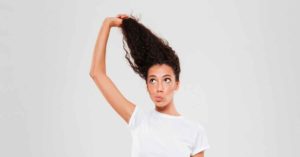
What Is Trichotillomania?
Trichotillomania is a condition, often categorized as a mental disorder, in which a person feels an overwhelming compulsion to pull their hair. The hair could be on their scalp, eyebrows, or other body parts, but the urge is persistent, distracting, and difficult to resist.
The repeated hair pulling can damage hair follicles, much like traction alopecia can. The pulling also creates patchy bald spots. Continued over time, the hair loss can become permanent.
In 2019, fashion blogger, Dani Austin admitted to switching to wigs to cover up her hair loss. Hair bleaching may have also been a factor leading to substantial hair breakage, but she also admitted to having the hair-pulling disorder, trichotillomania.
Is Trichotillomania an Anxiety Disorder?
Yes, though technically the National Center for Biotechnology Information (NCBI) labels it a “co-occurring anxiety disorder.” That means it’s a separate condition that frequently co-exists alongside an anxiety disorder.
So not everyone who suffers from anxiety will experience trichotillomania, but those with the hair-pulling disease usually suffer from anxiety as well. Fortunately, the hair-pulling disorder is considered a rare disease.
What Is the Cause of Hair Pulling?
According to the National Institutes of Health (NIH), the hair-pulling disorder can develop for one of a few reasons:
- As a way of coping with stress
- A neurological imbalance similar to obsessive-compulsive disorder (OCD)
- A side effect of anxiety
- Hormonal changes, especially during puberty
- Self-harm to provide relief from emotional pain
Unfortunately, any stress relief provided by the hair pulling is usually mitigated by the subsequent appearance changes. Shame, guilt, self-criticism, feeling like a failure for not being able to resist the compulsion, and other self-criticism just perpetuates the cycle of stress and anxiety, leading to more hair pulling.
How Do I Stop Pulling My Hair Out?
Since trichotillomania is a co-occurring condition with anxiety disorder, seeking treatment for anxiety is a good first step. Of course, mention the hair-pulling disorder to your doctor or therapist when you seek treatment for trichotillomania.
Additionally, the British National Health System (NHS) recommends the following to assist with the hair-pulling disorder compulsion:
- Squeezing a stress ball when the urge to pull hair occurs
- Keep a diary detailing what occurred before hair pulling
- Use the diary to figure out triggers and avoid them
- Substitute a healthy self-soothing technique
- Use a fidget toy instead of pulling hair
- Exercise
- Repeat a soothing phrase until the urge passes
If you’re suffering from hair-pulling disease, speak to your medical doctor or therapist for treatment. Once the disorder is managed, if you have patches of permanent hair loss, RHRLI may be able to help.
Book a Free Hair Consultation
If you’re concerned about your hair volume, damaged hair, a receding hairline, or any other type of hair loss issue, we can discuss it in a free consultation. Our state-of-the-art facility uses the ARTAS® robot for precise results and faster healing. To learn more as to why RHRLI is Long Island’s hair restoration leader, contact us today.
To watch a compilation of our patient reviews visit our YouTube page.
